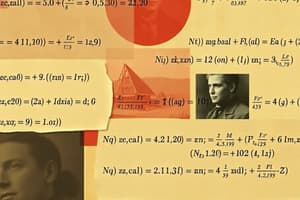Podcast
Questions and Answers
According to the quantity theory of money, what is the likely outcome if the money supply growth rate exceeds the GDP growth rate?
According to the quantity theory of money, what is the likely outcome if the money supply growth rate exceeds the GDP growth rate?
- Deflation
- Inflation (correct)
- Stable economy
- Increased velocity of money
If the Fed aims to decrease the money supply to combat inflation, which action would be most appropriate according to monetary policy tools?
If the Fed aims to decrease the money supply to combat inflation, which action would be most appropriate according to monetary policy tools?
- Open market purchases of government bonds
- Increasing reserve requirements (correct)
- Decreasing the interest paid on reserves
- Lowering the discount rate
How does the international trade effect contribute to the downward slope of the aggregate demand (AD) curve?
How does the international trade effect contribute to the downward slope of the aggregate demand (AD) curve?
- Lower domestic prices lead to decreased exports and increased imports.
- Higher domestic prices lead to increased exports and decreased imports.
- Higher domestic prices lead to decreased exports and increased imports. (correct)
- Lower domestic prices lead to decreased exports and decreased imports.
What characterizes the long-run aggregate supply (LRAS) curve?
What characterizes the long-run aggregate supply (LRAS) curve?
In the context of the AD-AS model, what characterizes a recessionary gap?
In the context of the AD-AS model, what characterizes a recessionary gap?
How does increased consumer confidence typically affect the aggregate demand (AD) curve?
How does increased consumer confidence typically affect the aggregate demand (AD) curve?
According to the Taylor Rule, how should the Federal Funds Rate be adjusted in response to an increase in the inflation rate above the Fed's target?
According to the Taylor Rule, how should the Federal Funds Rate be adjusted in response to an increase in the inflation rate above the Fed's target?
Which of the following is a key function of the Federal Reserve (Fed)?
Which of the following is a key function of the Federal Reserve (Fed)?
If a bank has a required reserve ratio of 0.10, what is the simple deposit multiplier?
If a bank has a required reserve ratio of 0.10, what is the simple deposit multiplier?
In the context of money creation by banks, what is the effect of increasing the reserve requirement?
In the context of money creation by banks, what is the effect of increasing the reserve requirement?
Which of the following is considered a component of M1 money supply?
Which of the following is considered a component of M1 money supply?
What is the primary characteristic of money that serves as a 'unit of account'?
What is the primary characteristic of money that serves as a 'unit of account'?
In a dynamic AD-AS model, what is the likely outcome if the aggregate demand (AD) shifts left due to policy or expectations, and the Fed responds by lowering interest rates?
In a dynamic AD-AS model, what is the likely outcome if the aggregate demand (AD) shifts left due to policy or expectations, and the Fed responds by lowering interest rates?
Which of the following scenarios would most likely cause a leftward shift in the short-run aggregate supply (SRAS) curve?
Which of the following scenarios would most likely cause a leftward shift in the short-run aggregate supply (SRAS) curve?
What is a key disadvantage of a barter system?
What is a key disadvantage of a barter system?
How do wages and input prices influence the short-run aggregate supply (SRAS) curve?
How do wages and input prices influence the short-run aggregate supply (SRAS) curve?
How would a weaker domestic currency typically affect net exports and the aggregate demand (AD) curve?
How would a weaker domestic currency typically affect net exports and the aggregate demand (AD) curve?
Which factor does NOT directly cause the AD curve to slope downwards?
Which factor does NOT directly cause the AD curve to slope downwards?
Using the rate change formula, calculate the rate change if point 1 is 5 and point 2 is 10.
Using the rate change formula, calculate the rate change if point 1 is 5 and point 2 is 10.
Which action by the fed does NOT influence money supply and interest rates?
Which action by the fed does NOT influence money supply and interest rates?
Flashcards
AD Curve
AD Curve
Shows the total demand for goods and services at different price levels.
Wealth Effect
Wealth Effect
Higher prices reduce purchasing power, leading to lower consumption.
Interest Rate Effect
Interest Rate Effect
Higher prices lead to higher interest rates, reducing investment.
International Trade Effect
International Trade Effect
Signup and view all the flashcards
Rightward Shift (Increase in AD)
Rightward Shift (Increase in AD)
Signup and view all the flashcards
Sticky Wages and Input Prices
Sticky Wages and Input Prices
Signup and view all the flashcards
Firm Output Response to Rising Prices
Firm Output Response to Rising Prices
Signup and view all the flashcards
Long-Run Aggregate Supply (LRAS) Curve
Long-Run Aggregate Supply (LRAS) Curve
Signup and view all the flashcards
Barter System
Barter System
Signup and view all the flashcards
Medium of Exchange
Medium of Exchange
Signup and view all the flashcards
Unit of Account
Unit of Account
Signup and view all the flashcards
Store of Value
Store of Value
Signup and view all the flashcards
Trust in Money
Trust in Money
Signup and view all the flashcards
Money Supply (M1)
Money Supply (M1)
Signup and view all the flashcards
Money Creation by Banks
Money Creation by Banks
Signup and view all the flashcards
Monetary Policy
Monetary Policy
Signup and view all the flashcards
Goals of the Fed
Goals of the Fed
Signup and view all the flashcards
Fed's Monetary Policy Tools
Fed's Monetary Policy Tools
Signup and view all the flashcards
Recession - Dynamic AD-AS Application
Recession - Dynamic AD-AS Application
Signup and view all the flashcards
Inflation - Dynamic AD-AS Application
Inflation - Dynamic AD-AS Application
Signup and view all the flashcards
Study Notes
- Formulas provided include rate change, quantity theory of money, Taylor rule, and the simple deposit multiplier.
- The rate change formula is (point 2 – point 1)/point 1 *100.
- The quantity theory of money formula is: Money supply growth rate + velocity growth rate = GDP growth rate + price level growth rate.
- The Taylor Rule formula is: Inflation rate = equilibrium Federal Funds Rate + 0.5(inflation rate – Fed's target rate of inflation) + 0.5(output gap).
- The simple deposit multiplier formula is 1/rr (rr = required reserve ratio).
Aggregate Demand and Aggregate Supply
- The Aggregate Demand (AD) Curve illustrates the total demand for goods and services at different price levels.
- The AD Curve slopes downward due to the wealth effect, the interest rate effect, and the international trade effect.
- The wealth effect says higher prices reduce purchasing power, which leads to lower consumption.
- The interest rate effect says higher prices cause higher interest rates, which leads to lower investment.
- The international trade effect says higher domestic prices result in fewer exports, and more imports.
- A rightward shift in the AD curve (increase in AD) is caused by increased consumption, investment, government spending, and net exports.
- Increased consumption results from higher wealth and consumer confidence.
- Increased investment comes from lower interest rates and business optimism.
- Increased net exports are due to a weaker domestic currency and foreign demand.
- A leftward shift in the AD curve (decrease in AD) is caused by the opposite factors.
- The Short-Run Aggregate Supply (SRAS) Curve slopes upward because wages and input prices are sticky, meaning they adjust slowly.
- Firms increase output as prices rise, which results in higher profits.
- Shifts in SRAS are caused by input prices, productivity changes, and supply shocks.
- Input prices include wages and oil prices.
- Supply shocks include natural disasters and technology.
- The Long-Run Aggregate Supply (LRAS) Curve is vertical and independent of the price level.
- It represents full employment output, which is potential GDP.
- Short-run equilibrium occurs where AD = SRAS.
- Long-run equilibrium occurs where AD = SRAS = LRAS.
- A recessionary gap occurs when AD intersects SRAS to the left of LRAS.
- An inflationary gap occurs when AD intersects SRAS to the right of LRAS.
Dynamic AD-AS Model Assumptions
- Prices and wages adjust over time.
- LRAS grows due to technology, labor, and capital.
- AD shifts due to policy and expectations.
Money, Banking, and the Federal Reserve
- A barter system requires a double coincidence of wants, making it inefficient.
- A barter system lacks a common measure of value, which reduces productivity.
Functions of Money
- Money serves as a medium of exchange used to buy goods/services.
- Money serves as a unit of account to measure value (prices listed in money).
- Money serves as a store of value, holding value over time (savings).
- Money serves as a standard of deferred payment for loans/future payments.
- Trust in money is established because it is backed by the government (fiat money).
- Money is accepted as legal tender.
- Money should be stable in value, which is achieved through low inflation.
- M1 money supply includes the most liquid forms of money, such as cash and checking accounts.
- M2 money supply includes M1 plus savings accounts and small time deposits.
- Banks lend out deposits through fractional reserve banking.
- The money multiplier is 1 / reserve requirement.
- Total money created = initial deposit × money multiplier.
- The Federal Reserve (Fed) was created in 1913 to stabilize the banking system, control the money supply, and act as a lender of last resort.
Quantity Theory of Money
- The equation for the quantity theory of money is MV=PY.
- MV=PY means Money × Velocity = Price × Output.
- Inflation occurs if the money supply (M) grows faster than output (Y).
- Deflation occurs if M grows slower than Y.
- A stable economy occurs when M grows at the same rate as Y.
Monetary Policy
- Monetary policy involves the Fed's actions to influence the money supply and interest rates.
- The goals of the Fed are price stability (low inflation), maximum employment, and moderate long-term interest rates.
- The money demand curve is downward sloping: higher interest rates lead to lower demand for money due to the opportunity cost of holding cash.
- The money demand curve shifts right with higher GDP and higher price levels.
- The money supply curve is vertical and controlled by the Fed.
- The money supply curve shifts right with open market purchases and lower reserve requirements.
Fed's Monetary Policy Tools
- The Fed uses open market operations (buying/selling bonds).
- The Fed sets the discount rate (interest on loans to banks).
- The Fed uses reserve requirements (rarely used).
- The Fed pays interest on reserves (new tool).
- During a recession, AD shifts left.
- The Fed lowers interest rates to increase the money supply, causing AD to shift right.
- During inflation, AD shifts right.
- The Fed raises interest rates to decrease the money supply, causing AD to shift left.
- Unemployment is high in a recession and low in inflationary gaps.
Studying That Suits You
Use AI to generate personalized quizzes and flashcards to suit your learning preferences.




